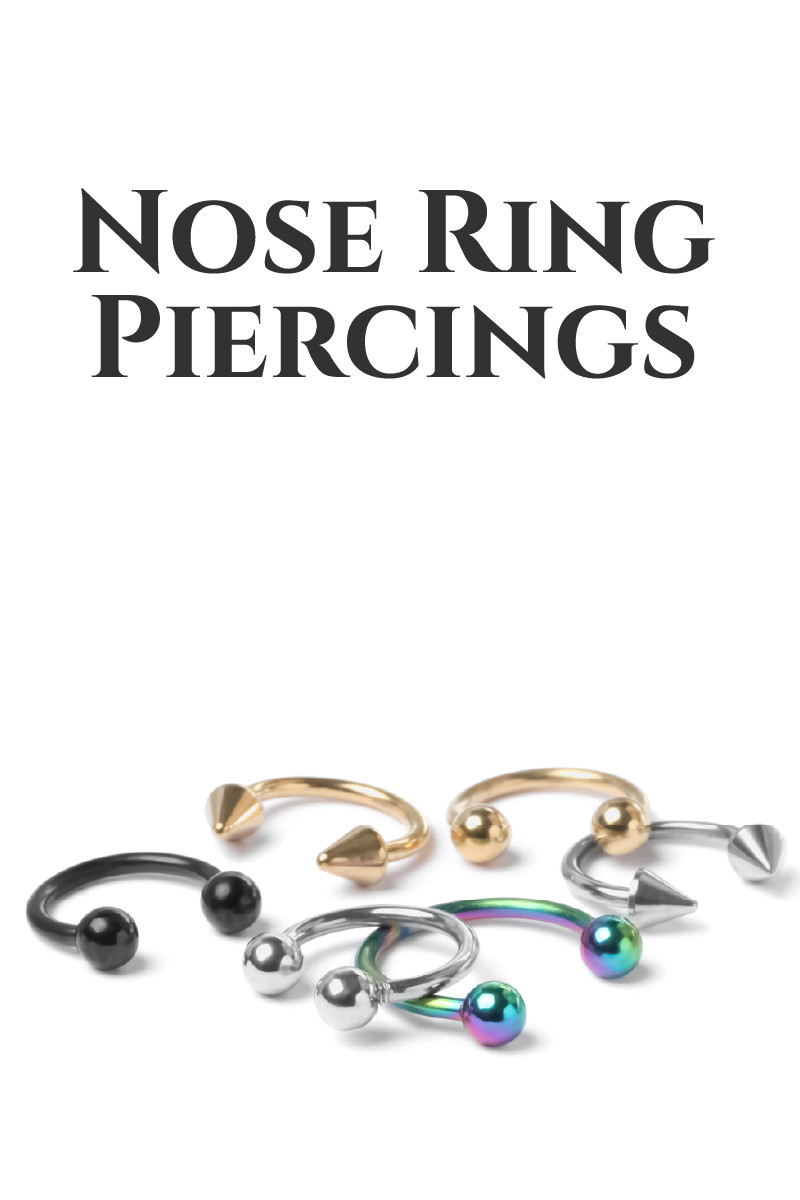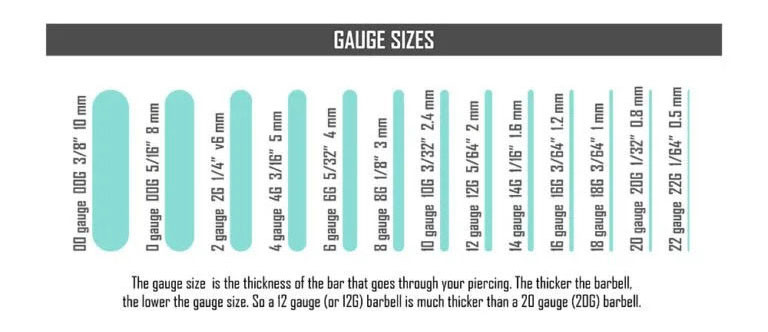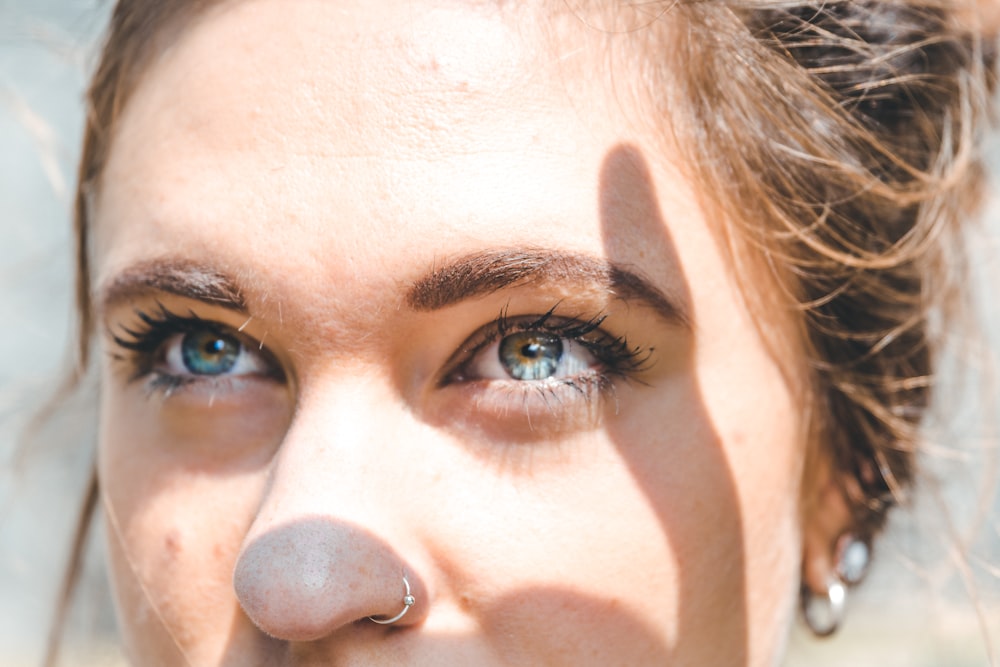
Nose Piercing 101: Types, Styles & Aftercare
 Today, nose piercings can hold cultural significance and express your individuality.
Today, nose piercings can hold cultural significance and express your individuality.
However, nose piercings go back thousands of years, with prevalence in Eastern cultures.
If you’re thinking of getting your nose pierced, we’re here to answer all your questions, including:
Types of nose piercing locations and jewelry
What to know before getting pierced
Piercing aftercare
Let’s dive in!

Types of Nose Piercings
The first decision when considering a nose piercing is the location, here are your options:
Nostril Piercing
A nostril piercing is timeless and a great location for your first nose piercing. This classic piercing goes through the center of the nostril, or higher on the bridge (called a “high nostril piercing”).
Jewelry ranges from understated studs to fashionable nose rings.
You can even get a double nose piercing, with one piercing on either nostril or two stacked on the same nostril, like a snakebite piercing.
Types of Jewelry: Rings, studs, and more
Septum Piercing
A septum nose piercing, or “bull ring,” goes through the “septal” cartilage separating your nostrils. This location has the potential for both bold masculine or subtle feminine jewelry, plus the convenience of easily hiding it for work if necessary (particularly with a circular barbell or horseshoe ring).
However, the area of skin is more complicated. It’s important to get your septum pierced by a reputable, experienced piercer to prevent infections, scarring, or a septal hematoma.
Septum piercings should be pierced for 14-gauge, 16-gauge, or a lower gauge. Some piercers may opt for 18-gauge, but any higher gauges aren’t recommended.
Types of Jewelry: Horseshoe ring (circular barbell), clicker, curved barbell, captive bead ring, seamless ring, crescent pincher, septum retainer
Septril Piercing
If you already have a stretched and healed septum piercing, you may be ready for a septril (or “jungle”) piercing. This complex piercing goes through the bottom of the columella (the cartilage pierced for a septum) and meets the healed septum hole, so the piercing comes straight out the center.
Your septal cartilage must have the right structure and position for this piercing to be manageable. Stretching the septum piercing takes time before you get a septril, but the result is certifiably badass.
Types of Jewelry: Small curved barbell, flat back stud
Rhino Piercing (Vertical Tip)
A novelty nose piercing is the rhino or vertical tip piercing, which goes vertically through the tip of the nose through the area above the septum. A deep rhino piercing goes through the bottom of the septum.
Rhino piercings, and deep rhino piercings especially, are more risky. The soft tissue is getting pierced and damage can require surgery, plus scarring is more common.
Types of Jewelry: Curved barbell; Straight barbell (deep rhino)
Bridge Piercing
A bridge piercing is a horizontal piercing through the soft tissue of the nose’s bridge between the eyes. These are surface piercings, meaning the entrance and exit holes are adjacent atop the skin.
Surface piercings are risky because the body tends to reject them more often. The body may reject it as it heals or years later.
You’ll need to avoid swimming, drinking, or smoking as your bridge piercing heals over 8 to 12 weeks.
Types of Jewelry: Circular, curved, or straight barbell
Austin Bar (Horizontal Nasal Tip)
This uncommon piercing is done horizontally through the tip of the nose without piercing the nostrils or septum.
It’s unique but quite painful — not recommended for your first piercing.
A similar-looking, less painful piercing is the mantis (or “forward facing nostril”) piercing, which is two piercings, one going through the front of each nostril.
Types of Jewelry: Straight barbell
Nasallang Piercing (Tri-Nasal)
This is similar to the Austin bar but exposed to the nasal cavities. It goes through one nostril, the septum cartilage, and the other nostril. The result looks like two studs on the upper nostrils.
The nasallang piercing requires a steady, professional hand, plus skill and symmetry to ensure that the barbell is straight.
It’s also pricier, considerably painful, and takes 6-12 months to heal — not recommended for your first piercing.
Types of Jewelry: Straight barbell
 Image credit: theSkimm
Image credit: theSkimm
Types of Nose Piercing Jewelry
Choosing the best type of jewelry for your nose piercing means considering the material, size, and shape.
Materials in Nose Piercing Jewelry
Nose piercing jewelry should be high-quality to prevent irritation or infection.
The best metals for nose piercings are:
Surgical Stainless Steel (SSS):
Pros: Inexpensive, fairly hypoallergenic, durable
Cons: Can contain some nickel
Best grade: 316L or 316LVM
Pros: Nickel-free, biocompatible, strong yet lightweight, corrosion-resistant
Cons: Expensive
Best grade: Grade 23 (G23) or implant-grade
Niobium:
Pros: Hypoallergenic, biocompatible, durable, priced between surgical stainless steel and titanium
Cons: Rarer, limited options
Best grade: Unalloyed (pure)
Other materials suitable for nose piercing jewelry are:
Platinum
Aztec Gold (a.k.a. PVD)
Solid gold (14K or higher)
Biocompatible polymers (e.g. Tygon)
Metals to avoid for nose piercing jewelry are:
Silver (including sterling silver)
Acrylic
Brass
Bronze
Plated metals
Plastics (excluding PTFE and Delrin)
Organic materials like wood, bone, and horn
 Image credit: Boelry
Image credit: Boelry
Nose Piercing Jewelry Sizes
Nose jewelry is measured in thickness (gauges) and length.
Thickness: Ranges from 00G to 22G; Lower gauge = thicker; Nose piercings are 16G, 18G, or 20G
Length: Rings typically 5/16” to 3/8" & studs typically 1/4" to 5/16”
Reputable piercers can advise the best jewelry size. Expect longer initial jewelry to accommodate swelling.
 Image credit: ThreadCurve
Image credit: ThreadCurve
Types of Nose Piercing Studs
Studs are great for a subtle, elegant look. A twist nose stud is typical for initial piercings, but other nose piercing stud styles include:
Twist Nose Stud: U-shaped post twisted in
Flat Back: Removable post with flat back
Labret: Straight post with flat back & threaded end (e.g. ball or gemstone)
L-Shaped: Post with 90-degree curve twisted in
Bone / Ball End: Straight post, nub on end
Straight End / Fishtail: Long, straight post, custom-bent by piercer
Pin: Straight, snug post
Corkscrew / Screw End: Straight prong, curved end, twisted in
Straight Barbell: Straight bar with unscrewable beads
Types of Nose Piercing Rings
Seamless Ring: Ends twisted away to open & close
Clicker / Segment Ring: Hinged end opens to insert, clicks to close
Septum Clickers: Small bar & hinged, circular piece
Captive Bead Ring: Hoop closed with removable bead
Circular Barbell / Horseshoe: Horseshoe-shaped & threaded, unscrewable beads on ends
Flat Disc Nose Hoop: Crescent or D-shaped, flat disc on one end, twisted open & closed
Crescent / Septum Pincher: Crescent-shaped, sometimes secured with o-rings
Curved Barbell: Slightly curved, unscrewable beads
Fake Nose Ring: Flexible ring squeezed closed
What type of nose ring should I start with? Most piercers use a barbell, twist nose stud, or horseshoe ring, depending on the piercing.
Is it better to get a nose ring or a stud? Follow your piercer’s guidance. You can experiment after it heals.

What Do I Need to Know Before Getting My Nose Pierced?
Let’s answer some common questions like:
How Much Does Nose Piercing Cost?
Nose piercings range from $20 to $100 without the added cost of jewelry.
Nostril piercings are most affordable. Nasallang, bridge, and septril piercings are priciest.
How Painful is a Nose Piercing?
Most people rank the pain at 3-4/10. Comparatively, they’re more painful than ear piercings.
Septum piercings can hurt more initially but quickly subside, while high nostril piercings may hurt more during recovery than initially.
How Long Does a Nose Piercing Take to Heal?
Each piercing is different:
Nostril: 4-6 months
Septum: 2-3 months
Septril: Around 9 months
Rhino: 6-9 months
Bridge: 8-10 weeks
Austin Bar: 2-3 months
Nasallang: 4-6 months
Do Nose Piercings Get Infected Easily?
Some symptoms are normal after a nose piercing: itching, white pus, some crust. Minor swelling, redness, bruising, and bleeding are also common. Irritation and inflammation should resolve after a week.
Signs of an infected piercing:
Smelly green or yellow pus
Excessive tenderness
Major throbbing or pain at piercing site
You can prevent infections with proper aftercare.

How to Care for Your Nose Piercing
New piercings require regular maintenance to heal. Clean it 1-3 times a day for the first 6 months.
Wash your hands thoroughly.
Soak a paper towel or cotton pad in saline solution & hold it on piercing for ~5 minutes.
Remove crust/discharge with cotton swab dipped in saline solution.
Gently pat dry with a clean paper towel.
Only use saline solution or what your piercer recommends. Hydrogen peroxide, rubbing alcohol, and Neosporin are no-nos. Also avoid:
Touching piercing before washing hands
Picking at crust
Twisting nose ring
Applying ointments to piercing
Swimming
Putting cosmetics or harsh soaps on the piercing
Sleeping directly on piercing

Is A Nose Piercing Right For You?
You have the info, now it’s time to choose the right nose piercing for you. Will you opt for a small stud nostril piercing or bold septum ring? The best choice is what feels right for you and your lifestyle.
Browse our collection of beautiful jewelry to complement your nose ring!
Search the Fashion Encyclopedia
Related Auctions
Related Articles
Jewelry gemstones are always tops in online demand
3rd Jan 2021
Sapphire Rings, Pendants & Earring Jewelry.Sapphire is a range of corundum, which is an aluminum oxide, and transpires in various colors such as pink, yellow, blue, and green. Any corundum jewel that is not red tone is known as sapphire.
10th Apr 2019
Amethyst Facts, Myths & Legends, Leonardo Da Vinci once wrote that Amethyst was able to dissipate evil thoughts and quicken the intelligence. * Amethyst was worn by Egyptian soldiers in battle for bravery and courage.
13th Jun 2019
Latest Articles
Titanium is a popular jewelry metal known for being lightweight, durable, and affordable. Learn all about titanium, how it compares to similar metals, and the pros and cons of titanium jewelry.
7th Feb 2023
Learn all about tungsten jewelry - from its history and uses to its durability and care. By the end of our guide, you’ll know if tungsten is right for you!
7th Feb 2023
Thinking about adding some timeless white gold jewelry to your fine accessories collection? Here’s all there is to know about sophisticated white gold!
29th Jan 2023








